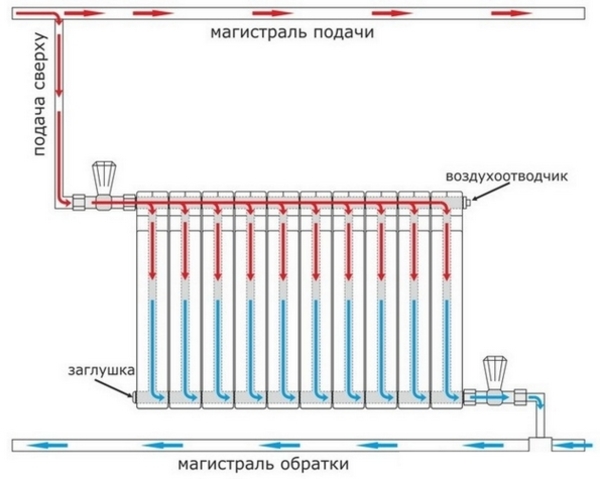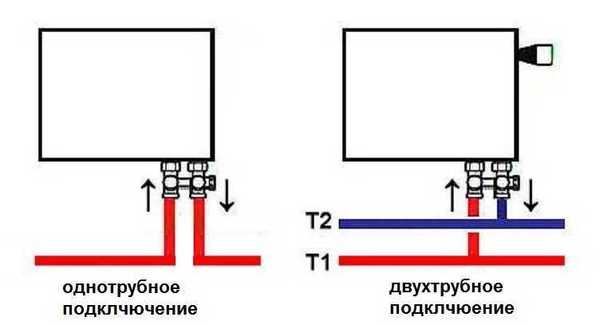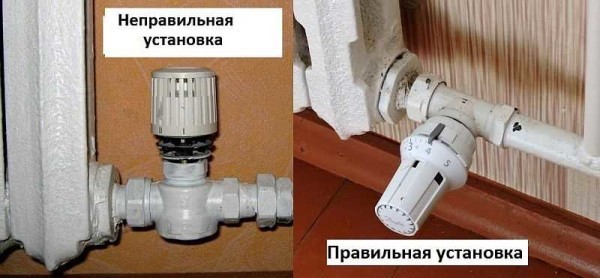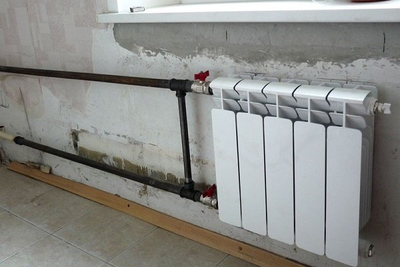And let there be warmth in every corner! How to properly connect a heating battery in an apartment

Incorrect switching on of heating radiators - the factor that most often causes problems during operation.
Errors in the installation of other components and the wrong choice of the type of system also have a negative impact on the use of heating devices.
How to properly connect batteries in an apartment building

Connection options depend on the number of pipes used to connect the boiler to the radiators. There are two methods:
- One pipe comes out of the boiler, makes a circle around the harness, entering the batteries along the way, and returns to the starting point. This method of installation is easy to implement.
- The first half of the system comes out of the heater, visits all radiators, connecting with them only once. In the extreme, most remote one, it stops and the second part begins. The latter also passes through all batteries, connecting on the other side. Its final point is the cauldron.
The choice will depend on the budget, because Both options have advantages over the other.. Single-pipe is easier to install and cheaper, which is why it is used in apartment buildings. Two-pipe is more complex and expensive, but more reliable, so it is recommended for private buildings.
Schemes for the correct connection of radiators to the heating system
The pipes are connected to the radiators in three ways:
- Diagonal option implies connecting the feed to the upper axis on one side of the battery, and the return to the lower axis on the other. This type is characterized by high operating efficiency and rapid heating of sections, regardless of their number and distance from the boiler.

Photo 1. Diagram of diagonal connection of heating radiator. Supply circuit is on the top left, return circuit is on the bottom right.
- Bottom The connection is made along one axis. To do this, the feed is cut into one edge of the radiator, and the return is cut into the other. This method is used less often than others due to its low efficiency.

Photo 2. Diagram of the lower connection of batteries for a one-pipe system (left) and for a two-pipe system (right).
- Lateral also known as one-way. Pipes are supplied from one side in a vertical plane. This method is in great demand in small rooms and apartments.
You can use each type of connection as they do not depend on the heating system. But in the work of different combinations there are nuances that it is advisable to observe.
Reference. Single pipe layout is better combined with bottom and side connections, and a two-pipe one - with diagonal.
Incorrect connection methods
Radiators are usually installed without problems, but the same cannot be said about some system components.
Thermostat head
Errors during installation of the device lead to a decrease in operating efficiency. The most common causes of problems are:
- Vertical head placement do so that it does not stick out to the side, interfering with walking or cleaning. This leads to heating of the bellows, since the coolant rises from the valve upwards. To correct this, it is necessary to stop operation, dismantle the device, then install it again, placing it horizontally.

Photo 3. Incorrect vertical connection of the thermal head to the battery (left), correct horizontal placement (right).
- Placing the thermal head in a niche or similar confined spaces. This leads to a decrease in convection: heat settles in a closed volume, accumulates and is incorrectly reflected from the surrounding walls. Thus, the heating efficiency decreases.
- Installing curtains so that they cover the thermal head. This factor leads to the incorrect determination of the room temperature by the device. The bellows stops working when it is necessary. Solution to this problem — placing the sensor on a wall that is not covered by unnecessary objects. Most thermal heads are allowed to be mounted at a distance of up to two meters from pipes.
- High-quality adjustment of the device also plays an important role. It is recommended to invite a specialist who will check the correct operation and, if necessary, change the characteristics.
Bypass

Problems with the device usually arise when radiators are replaced by an unqualified person. This is especially true for cases in which cast iron is replaced with another material.
The two most typical mistakes are:
- Installation of a ball valve on a bypass supply pipe, designed to start water in the system. The entire coolant should not pass through the device: only a small part, which is enough for operation.
- The bypass is connected to the piping through a mixer with a three-way valve. Theoretically, this allows you to regulate the heat output of the boiler, but in practice it leads to damage to the device.
Both errors are fairly easy to fix by changing the bypass connection principle. There are also a few rules to note:
- It is prohibited to install a bypass on a free pipe in apartment buildings.
- It is prohibited installation of shut-off valves and fittings.
- Allowed reduction of pipes by one typical size.
- In a non-volatile gravitational system pump required, and it is connected exclusively to the bypass.
Attention! The problems mentioned concern only multi-apartment buildings in which they lead to an imbalance in the entire systemThe consequence of such errors is a decrease in the amount of heat received by neighbors along the main line.
The types of installation described above are not desirable, but rarely cause accidents in private buildings. This is due to the absence of other users who may have a different system configuration that cannot be combined with the rest.
Useful video
Watch a video that explains how best to connect a radiator in a new building.
Follow the rules — vital!
Correct connection of components guarantees long-term operation of devicesIt is recommended to invite a heating specialist to check or perform installation.








